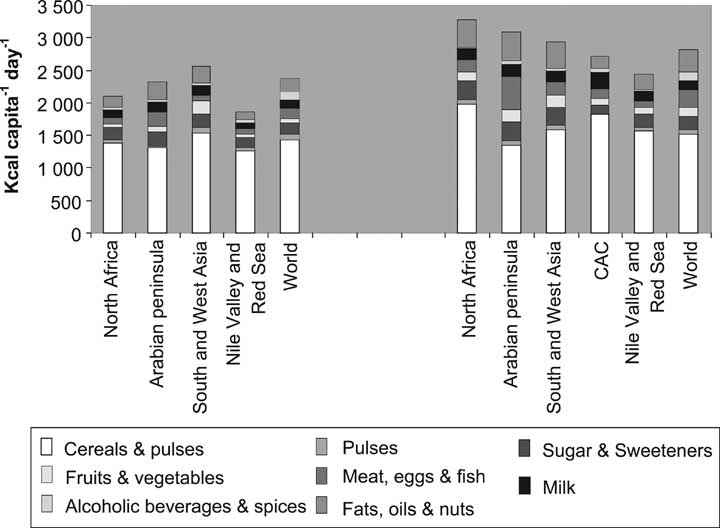
| Previous | Return to table of contents | Search Reports | Next |
| « Back to weltagrarbericht.de | ||
64 | Central and West Asia and North Africa (CWANA) Report
|
The general nutritional status of the CWANA countries has improved. Significant progress was made in raising the per capita daily food consumption in kcals per person, the key variable measuring and evaluating the world food situation. The average national food consumption per person in CWANA has increased quite satisfactorily since the 1960s and will likely continue. This is projected to increase from 3006 kcals in 1997-1999 to 3090 kcals in 2015 and close to 3170 kcals by 2030 (Figure 2-4). In addition, the per capita daily food intake changed, particularly in the oil-rich Arabian Peninsula countries. The increased consumption of meat, particularly poultry and eggs, milk and milk products, fats, oils and nuts has been spectacular. North African countries, thanks to imports, increased dramatically their consumption of cereals, starchy roots (mostly potato), sugar and other sweeteners, milk and milk products. All, particularly South Asian and West Asian countries, are great consumers of fruits and vegetables, although the difference between the world average and the CWANA average seems narrow. While the average consumption worldwide of fruits and vegetables has increased, the consumption in CWANA has decreased from their high consumption in the 1960s. The average daily food intake in all CWANA continues to be dominated by vegetables, with animal products, especially meat, eggs, fish and seafood lagging far behind world averages. When compared with consumption in industrialized Western countries, this gap is even wider. The relatively high consumption of pulses somewhat narrows this protein gap. Finally, it must be remembered that the progress shown by the positive figures for daily food intake between the 1960s to |
the 2000s do not reflect the uneven food distribution among the socioeconomic classes and poor rural areas. 2.4.3 Local markets and marketing channels Market accessibility is becoming key to rural development. The lack of links between rural and urban areas is the largest constraint to improving rural livelihood. In addition, most farmers in CWANA are small landholders and have limited money to invest in new technology to improve their yields. Since the mid-1980s, governments have improved the facilities for agricultural produce and market access for small landholders. In Tunisia and Morocco, milk collection centers have considerably helped increase marketed milk. In Turkey, successive governments oriented public credits through agricultural cooperatives to install greenhouses in horticultural regions and improve the conditioning facilities for fresh produce. However, despite these measures, most agricultural and livestock production is marketed through long marketing channels where middlemen keep much of the value created in supply chains; landholders mostly receive less than 30% of the final market price. Traditional marketing channels, from the farmer to the consumer, comprise many marketing agents: the village tradesman, commissioner, wholesaler, industrial processor, retailer for the domestic market and the village tradesman, commissioner, wholesaler and exporter for exported products. These long marketing channels are harmful for the quality of agricultural and food products and for the food safety. The poor quality and small volume of agricultural produce create bottlenecks for industrial processors and ex- |

Figure 2-4. Composition of per capita daily food intake. Source: FAO database
| Previous | Return to table of contents | Search Reports | Next |
| « Back to weltagrarbericht.de | ||